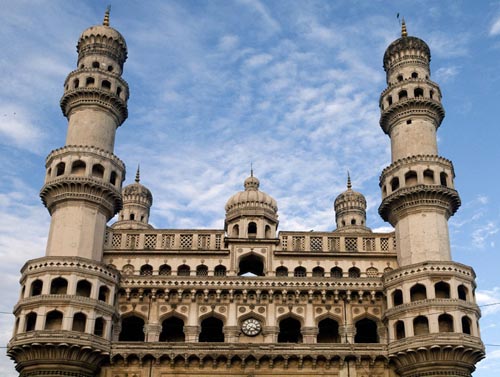Charminar Hyderabad

Information on Charminar (Hyderabad, Telangana) - History & Architecture
The Charminar is a wondrous monument and mosque in Old City of Hyderabad region, in the state of Telangana, India. The Mosque is on the second floor of this structure. It was build in 1591 CE. It is one of the most recognized structures of this nation. This particular landmark is the iconic attraction of Hyderabad, visited by huge number of tourists from across India and abroad. It is very near to Makkah Masjid and lies on the east bank of Musi River. The Urdu language words Char and Minar means in English language as "Four Towers". It is to be highly noted that the intricate towers are grandly ornate minarets which are supported and attached by four grand arches.
According to the Archaeological Survey of India (ASI) who is the present caretaker of this structure cites that at the center of the city, Charminar was constructed in order to commemorate the successful eradication of plague. It is to be highly remembered that Muhammad Quli Qutb Shah had wholeheartedly prayed for the immediate end of a plague that was devastating his city so he promised to construct a Mosque at the actual spot where he prayed.
Charminar Hyderabad Architecture
Charminar belongs to the Indo-Islamic architecture style that has shades of Persian architectural elements in it. It is made of pulverised marble, limestone, granite and mortar. The structure was intended to actually serve as a Madraasa and Mosque for the local people. It is a square shaped structure with each side nearly 66 feet (20 meters) long, with four arches of grand manner each directly facing a key point that immediately open into four streets. An exquisitely shaped minaret, at each corner stands with nearly 184 feet (56 meters) high. The structure has double balcony. With dainty petal-shaped designs at the base and with a bulbous dome, each minaret is crowned. In order to reach the upper floor, there are 149 marked by repeated turns and bends steps. This particular structure is also popular for its arrangement of its balconies and balustrades plus profusion of stucco decorations.
It strongly believed that there is a tunnel underground connecting directly the Golkonda Fort with Charminar but it is still unknown. At the western end of the open roof in the second floor a mosque is perfectly located. On the other hand, remaining part of the roof largely served as a court for conducting religious meetings during the Qutb Shahi times. In 1889, on the four cardinal directions clock was added. In the middle, there is a water cistern with a small fountain for ritual washing before offering prayer in the Mosque located in Charminar.
Charminar Hyderabad History
The fifth ruler of the Qutb Shahi dynasty, Muhammad Quli Qutb Shah commissioned the construction of Charminar. On the significant intersection of the historical trade route that directly connects the port city of Masulipatnam with markets of Golconda, this particular structure was built. With Charminar as its centerpiece, the Old City of Hyderabad was rightly designed. The city was spread around this particular structure in four different chambers and quadrants, segregated as per the established settlements. In the cardinal directions towards the north of Charminar is the four gateways or Char Kaman constructed. Qutb Shah's prime minister named Mir Momin Astarabadi played a significant role in perfectly preparing the layout master plan for the grand structure of Charminar along with the new capital city in a successful manner.
Charminar Hyderabad Tourism Importance
Among the domestic and foreign tourists, Charminar is the most sought after destination in Hyderabad. Laad Baazar located in its neighborhood is popularly known for jewellery and exquisite bangles. On the other hand, the Pather Gatti is known for pearls. It is to be remembered that in its heyday, the markets surrounding Charminar had nearly 14,000 shops which catered to the needs and requirements of the local people.
- Andaman Nicobar Monuments
- Andhra Pradesh Monuments
- Assam Monuments
- Bihar Monuments
- Chhattisgarh Monuments
- New Delhi Monuments
- Goa Monuments
- Gujarat Monuments
- Haryana Monuments
- Himachal Pradesh Monuments
- Jammu and Kashmir Monuments
- Karnataka Monuments
- Kerala Monuments
- Madhya Pradesh Monuments
- Maharashtra Monuments
- Odisha Monuments
- Punjab Monuments
- Rajasthan Monuments
- Tamil Nadu Monuments
- Telangana Monuments
- Uttar Pradesh Monuments
- West Bengal Monuments